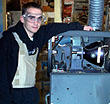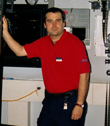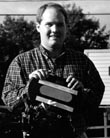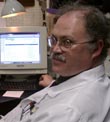|
|
 
|
|
Author
|
Topic: Reverse Scan on Automation
|
|
|
|
|
|
|
|
|
|
|
|
|
Jack Ondracek
Film God

Posts: 2348
From: Port Orchard, WA, USA
Registered: Oct 2002
|
 posted 09-21-2003 11:12 AM
posted 09-21-2003 11:12 AM





quote:
Since Dolby processors (and, I assume, others) have electronic switching for changeover and format selection, there's no reason not to leave the exciter/LED on all day. Or am I missing something?
Sounds like if he uses the same logic, the processor will switch from music to film audio when the motor starts. If the LED is on, everyone hears the leader.
Paul, I had that problem in Port Townsend when we automated that place. The theatre uses a Co-Operator, so an abundance of programmable outputs wan not available.
Vern talked this over with CE, and said the power supply is current-limited enough that switching the LED wouldn't be a problem. What IS a problem is that the LED is so fast it puts quite a click in the audio when it's switched. I put a little resistance & a small cap in the line to smooth that out & it's worked fine... about 6 years or so now. This would allow you to use an extra contact from your slide relay (if you're using one) to switch the Ultra Stereo over, and you can use the dry contacts from the exciter switch to run the LED.
| IP: Logged
|
|
|
|
|
|
|
|
|
|
|
|
Jim Alexander
Film Handler

Posts: 71
From: Greenwood, Nova Scotia, Canada
Registered: Nov 1999
|
 posted 09-22-2003 02:42 PM
posted 09-22-2003 02:42 PM





Although we don't have automation, we do have a CE reverse scan reader. As Gordon stated, wiring it to the motor start works quite well for us. The only difference is the power to the LED/Reader power supply is there on main power to the booth. On the power supply is two lugs used to provide soft power on to the LED and reader. When shorted, the power supply if "Off", when open it is "On". By integrating a relay to the motor start switch that energises and open these contacts, our reader and LED come on when they are needed.
Although this is not an automation system, I'm sure the same principle applies to the automation system. If your system has constant contact, no problem, if momentaty contact, then a simple latch relay, inline, would solve this.
Just a thought
[ 09-22-2003, 04:35 PM: Message edited by: Jim Alexander ]
| IP: Logged
|
|
Paul G. Thompson
The Weenie Man

Posts: 4718
From: Mount Vernon WA USA
Registered: Nov 2000
|
 posted 09-22-2003 09:51 PM
posted 09-22-2003 09:51 PM




Gentlemen, maybe I did a poor job in explaining this.
Once again:
1. The LED power supply is on at all times.
2. The Ultra Stereo gets a "holding closure" for non-sync via a relay that is on the motor circuit.
3. When the motor is started, the non-sync "holding closure" is immediately deactivated and the Ultra Stereo switches into the stereo format.
4. As the motor ramps up, all the crap the scanner sees is going out into the auditorium speakers.
5. When the movie is over, the change-over closes but all the tail-out crap still goes into the auditoruim.
6. When the motor finally shuts down, THEN the Ultra Stereo will go into the non-sync mode because the motor relay will send a closure to the Ultra Stereo.
This is not cool to allow it to continue. It is very hard on speakers, drivers, amplifiers, and the ears of the customers sitting in the auditorium and it makes us look like shit.
When the incandescent exciter lamp was being used before the conversion, the exciter lamp was switched on by the exciter relay at the same time the change-over relay opens the change-over douser. At the end of the movie, the exciter lamp was extinguished by teh exciter relay contacts at the same time the change-over douser closed.
What I was asking is whether or not the LED power supply would remain happy with 4 cycles per day over a period of time. By the answers some have posted, it sounds like it would stay happy as long as I didn't put a switching relay in the output side of the power supply.
If the power supply protested that, I would have made another approach....by using latching relays for the non-sync and stereo formats in this old processer in such a manner as to where the sound window would remain closed from the time the motor starts to the time the change-over douser opens and conversely, closing the sound window from the time the change-over douser closes and the motor shuts down on tail-out.
In short, I only want the sound window open when ther is a picture on the screen. Not before and not after. ![[Smile]](smile.gif) ![[Smile]](smile.gif)
By reading your replies, I am convinced I did a shitty job of explaining what I wanted to do and how. ![[Smile]](smile.gif) Sorry for the confusion I caused. Sorry for the confusion I caused.
| IP: Logged
|
|
|
|
All times are Central (GMT -6:00)
|
|
Powered by Infopop Corporation
UBB.classicTM
6.3.1.2
The Film-Tech Forums are designed for various members related to the cinema industry to express their opinions, viewpoints and testimonials on various products, services and events based upon speculation, personal knowledge and factual information through use, therefore all views represented here allow no liability upon the publishers of this web site and the owners of said views assume no liability for any ill will resulting from these postings. The posts made here are for educational as well as entertainment purposes and as such anyone viewing this portion of the website must accept these views as statements of the author of that opinion
and agrees to release the authors from any and all liability.
|

 Home
Home
 Products
Products
 Store
Store
 Forum
Forum
 Warehouse
Warehouse
 Contact Us
Contact Us




 Printer-friendly view of this topic
Printer-friendly view of this topic







![[Smile]](smile.gif)

![[Confused]](confused.gif)




![[Big Grin]](biggrin.gif)
![[thumbsup]](graemlins/thumbsup.gif)




